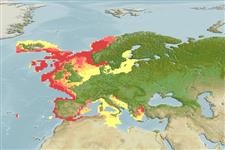Common names from other countries
Environment: milieu / climate zone / depth range / distribution range
экология
; пределы глубины 20 - 800 m (Ref. 441), usually 200 - 600 m (Ref. 88009). Temperate, preferred 16°C (Ref. 107945); 72°N - 27°N, 25°W - 27°E
Eastern Atlantic and the Mediterranean: From Finnmark, Norway south to Libya west to the Canary Is. and east to Aegean Sea. Subtropical to polar.
Length at first maturity / Size / Вес / Возраст
Maturity: Lm 3.2, range 2 - 5.5 cm Max length : 24.0 cm BL самец/пол неопределен; (Ref. 441); common length : 19.0 cm BL самец/пол неопределен; (Ref. 441)
Total body length: 8 to 24 cm, usually between 10 to 20 cm (Ref. 4). Found in the continental shelf and slope (Ref. 94799). Epibenthic (Ref. 87524). Sedentary (Ref. 94799). Inhabits muddy bottoms in which it digs its burrows. Nocturnal and feeds on detritus, crustaceans and worms (Ref. 4). An active predator or scavenger (Ref. 94757). Another isotope data (δ15N=6.26±0.14, n=3, Ref. 106518).
Ovigerous females are found practically throughout the year, the eggs laid around July are carried for about 9 months (Ref. 4). 1 brood per year (Ref. 81133); 1.6 cm postlarval size (Ref. 81161); 1 month of pelagic period (Ref. 81160).
Основная ссылка
ссылки | координатор | соавторы
Holthuis, L.B. 1991. (Ref. 4)
Статус Красного Списка МСОП (Ref. 130435)
Статус СИТЕС (Ref. 108899)
Not Evaluated
Not Evaluated
Использование человеком
рыболовство: коммерческий
FAO - рыболовство: landings, Видовой профиль | FIRMS (Stock assessments) | FishSource | Sea Around Us
инструменты
дополнительная информация
ресурсы в Интернет
Estimates based on models
Preferred temperature
(Ref.
115969): 3.3 - 13.7, mean 7.8 (based on 273 cells).
устойчивость к внешним воздействиям
средний (среднего размера), минимальное время удвоения популяции 1.4-4.4 года (K=0.03-0.44; tm=2).
Prior r = 0.50, 95% CL = 0.33 - 0.75, Based on 36 full stock assessments.
Уязвимость
Low vulnerability (14 of 100).
